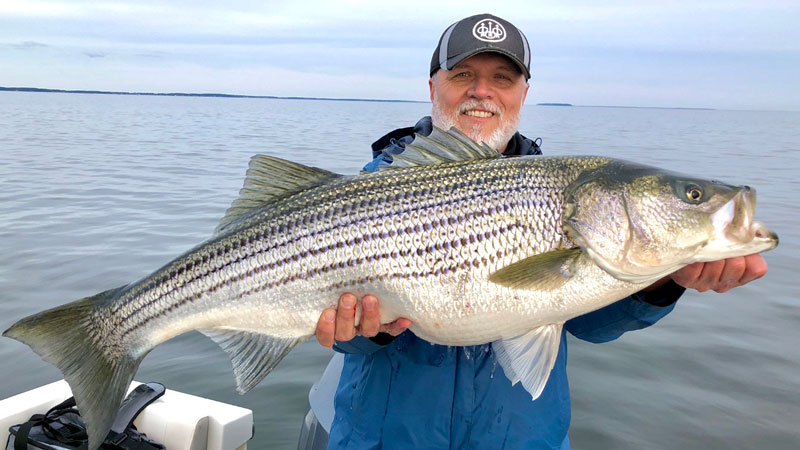This month we chat with Capt. Larry Geipe of Chasing Light Charters, about chasing striped bass and other fish on the Bay as fall sets in.

Q: Tell us what gear you use for rockfish in late fall.
A: In addition to finding school-sized fish larger ocean fish will begin migrating into the Bay so it’s best to be able to cover a wide range of possibilities in terms of lure sizes and weights. Half of my gear will consist of 6’6” medium extra fast rods, 2500 to 3000 class spinning reels spooled with 10-pound braid, and 20-pound mono leaders. On these, I’ll cast BKDs and 5” paddletails rigged on 1/4- to 3/4-ounce jig heads. The other half of my gear will consist of 7’0” medium-heavy rods, 3000 class spinning reels spooled with 10- or 15-pound braid, and 20- to 30-pound mono leaders. On these rigs I’ll cast 6” to 7” paddletails rigged on one or 1.5-ounce jig heads.
Q: Rank your top three favorite colors for us, and tell us how you choose which to use and when.
A: You can’t go wrong heading out on the water with the two Chesapeake favorites: chartreuse and pearly white. But there are so many great colors on the market and it’s always good to experiment and mix it up. If you are not catching fish, keep switching things — colors, weights, and presentations. Also, adding skirts to plastic baits is a great way to increase variety in both lure color and action.
Q: We all hope to find breaking fish this time of year, but sometimes it just doesn't happen. When birds are MIA, what's your next move? What sorts of areas do you head for?
A: It can be a blessing when breakers and birds appear, but there are many days when it doesn’t happen. My advice is to put the binoculars down and rely more on your sonar. Your electronics are your best friend and it’s all about finding the bait. If you are not finding bait, move on until you do. As you search, think in terms of patterns: river mouths, ledges, humps, points, and channel edges. Analyze your chart and think of how the current might be moving schools of bait over ambush points. If you get into a pocket of good fish, look for the same pattern elsewhere on your chart.
Q: Do you have any favorite species other than rockfish you like to pursue in late fall? If so, give us the lowdown on what you use and how you find 'em.
A: It really depends on the weather. If we have a warm October and there haven’t been any significant cold fronts, it’s possible to still encounter big blues, reds, and maybe some specks that are still hanging around.
Q: Tell us your number one tool for catching fish OTHER than rods, reels, and lures, and give us one great tip for using it.
A: I consider sonar to be my greatest tool for catching fish. I rely heavily on traditional, side-scan, and forward-looking (LiveScope) sonar to locate fish. Anglers who develop skill in reading side-scan out to distances of over 70’ have a real advantage in finding fish. Until you are sure what you are looking at, it’s best to work with smaller distances on your side-scan and move out from there as you gain confidence.
Q: If you could say anything to all the anglers out there, what would it be?
A: Resist the urge to crowd other anglers or run your boat directly into working birds. It can be very tempting to want to get in close to others who are having success, especially if you are not, but engine noise is a proven bite-killer and motoring in close will not only shut down the bite for others, but for you as well. Stealth and etiquette are called for in these situations. Cut your drift up-current from the action such that you can drift through the area with your engine off and at a reasonable distance from others. Fish move around and they are just as likely to move under your boat as they were to go under the boats of the people who were there before you. Also keep in mind that bigger fish are often deeper and further off the smaller fish that might be breaking the surface. I’ve had some of my best days on big fish watching others jockeying for position under birds hundreds of yards away from where I was.
You can contact Captain Larry via ChasingLightCharters.com, at [email protected], or by calling (410) 405-7172.